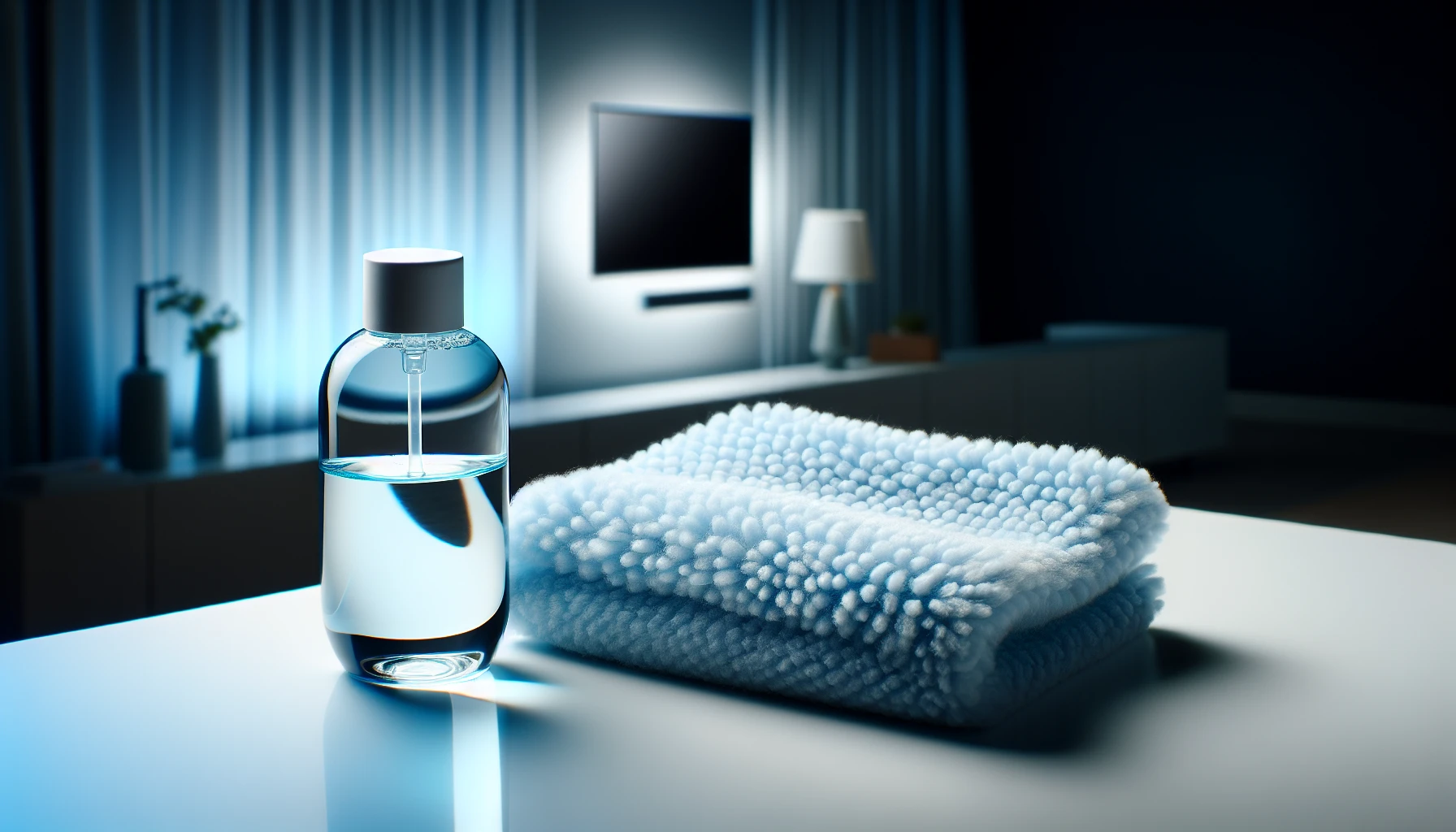The Ultimate Guide on How to Clean a TV Screen Safely and Effectively
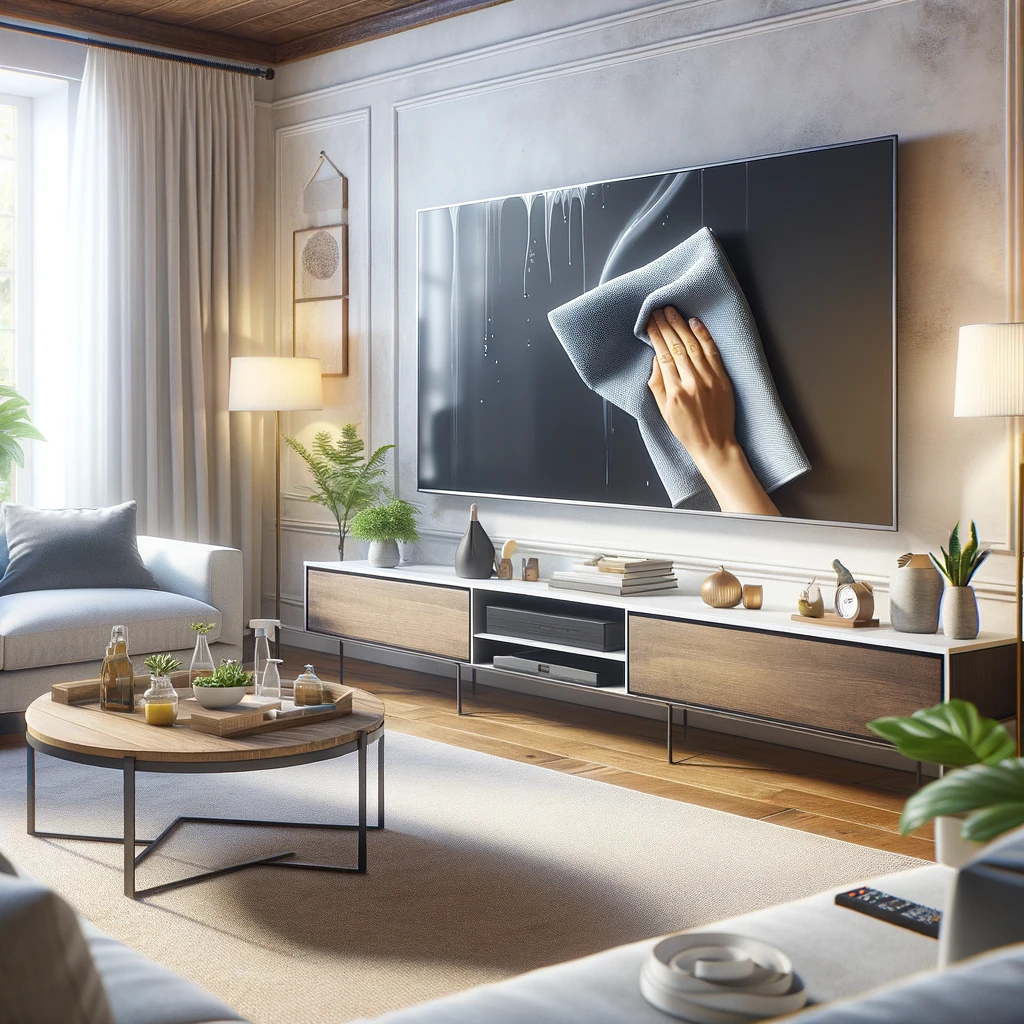
A clean TV screen is essential for an optimal viewing experience, but with so many different types of screens and cleaning products on the market, it can be challenging to know what’s best for your TV. This ultimate guide on “how to clean a TV screen” will walk you through cleaning various TV screens safely and effectively, ensuring a clear and streak-free viewing experience that preserves your TV’s lifespan.
Key Takeaways
- Opt for a microfiber cloth and mild dish soap when cleaning your TV screen.
- Power down the TV before cleaning, dust regularly with a dry cloth and use gentle circular motions to tackle stubborn stains.
- Take preventive measures such as avoiding touching the screen and keeping it in a low-dust environment to maintain cleanliness.
Essential Tools for Cleaning Your TV Screen
Correctly using tools is imperative to ensure a secure and efficient cleaning operation. The selection of appropriate clothes and the choice of cleaning solution can help protect your flat-screen TV while maximizing its life expectancy. When addressing how best to clean television screens, particularly when precisely cleansing them with window cleaner or other substances, one must consider all necessary equipment involved in this process, such as TVs, LCD screens, cloths, and cleaning solutions.
Choosing the Right Cloth
Using the proper cloth when cleaning your TV is critical to a pristine, clear finish. Regarding modern television sets, microfiber fabrics are an excellent option. They provide multiple benefits over other materials due to their softness and non-abrasive properties, which make them well-suited for sensitive screens. These types of clothes won’t leave any traces behind while lifting dust particles as effectively as possible - not only that, but you can also use them many times after washing thanks to their durability and eco-friendliness in terms of cost savings. Of particular importance, if we’re talking about contemporary TVs, is making sure the fabric used has anti-static qualities. Hence, its power prevents surface accumulation, keeping it dirt-free for extended periods. Selecting this sort of microfiber material guarantees successful results every time one cleans a television screen with no worries whatsoever!
Selecting a Safe Cleaning Solution
When cleaning your TV or computer screen, the type of solution is equally important as selecting the proper cloth. Strong chemicals such as alcohol and ammonia should be avoided because they can damage the coating and the display. Instead, use a mild detergent mixed with distilled water or a specialized television/computer cleaner. Hard water on its own may leave deposits behind that will affect anti-glare qualities, so utilizing purer forms of H20 in combination with soap would work well when prepping your liquid cleanser. When wiping down the monitor, use dampened fabric only; spraying directly onto any part could cause irreparable harm!
Step-by-Step Guide to Clean Flat Screen TVs
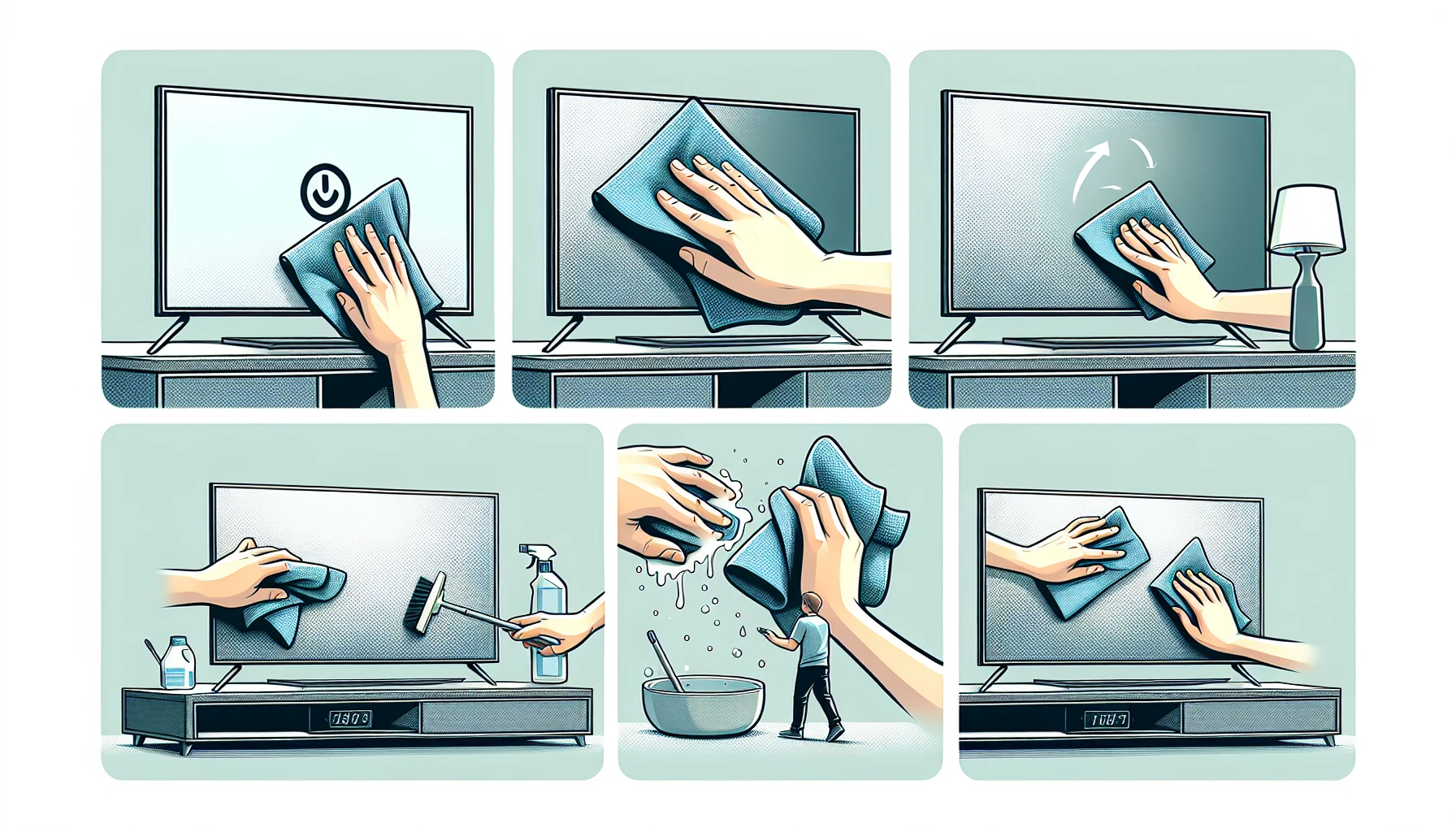
Now you’re equipped with the suitable materials, let’s get going. Here is a tutorial that will help you clean your flat-screen TV properly so it can give you an optimal viewing experience. Just follow these steps for spotless results!
Power Down and Cool Off
When you are about to clean your TV screen, you must turn off the television and disconnect its cord from any power source to avoid potential electric shocks. Ensure the unit cools down for a few minutes before beginning so smudges and dirt can be removed more effectively on a more excellent surface. The lack of backlighting or image makes dusting easier, as spotting specks and stains will no longer be anything distracting. Thus making the cleaning procedure safer overall. Identifying these blemishes helps guarantee an effective cleaning process by switching off/unplugging your TV first, then allowing it time to cool down sufficiently beforehand.
Dusting Off the Surface
Wipe your unplugged TV screen in round motions using a soft and dry microfiber cloth to eliminate dust particles. Care must be taken not to apply too much pressure since it can cause long-term harm to the delicate display. To avoid an accumulation of dirt that might decrease image quality and sound clarity, clean regularly with a static-cling duster or dry microfiber fabric. Doing so will help maintain vivid visuals on the television’s surface while preserving its life expectancy at optimal levels.
Tackling Stubborn Stains
Use a dampened, clean microfiber cloth with an appropriate cleaning solution, such as watered-down mild dish soap or specialized TV screen cleaner, for those problematic spots or streaks. Refrain from using paper towels and gently rub the stained areas in circular motions without applying too much pressure. It is important not to spray any of the cleansing formula directly onto the display, for it can cause harm to both its surface and inner functions. By simply moistening your cloth, you can effectively remove hard stains on your TV screen while avoiding damage at all costs.
Cleaning Other Parts of Your TV
It is essential to keep other areas of your TV clean, such as the speakers and remote controls, to maintain a high level of performance. This article will discuss how best to take care of these components to continue enjoying your television system at its optimum condition.
Speakers Care
To maintain crisp sound quality, it is essential to regularly clean the TV speakers and keep dust away from them. A microfiber cloth can be used to wipe down the speaker and gently cover it so as not to damage sensitive components. If these covers are removable, they should be carefully taken out before being wiped with a soft dampened cloth mixed in dish soap solution - avoiding any other type of chemical cleaner or pre-moistened wipes that could potentially harm components further. Regularly cleaning your television’s speakers using this method will ensure great audio while watching movies and shows!
Remote Control Maintenance
Maintaining a remote control is an essential yet often-forgotten part of cleaning. Removing the batteries and using a cotton swab or soft brush can help remove dirt lodged between buttons, crevices, and other small areas. To effectively clean it, Dampen a cloth with rubbing alcohol mixed with water (equal parts), then use this to wipe down the entire device. Take extra precautions so no liquid penetrates inside, as you would want air to dry out any excess moisture before reinserting the batteries for an enhanced TV viewing experience! Keep your remote control germ-free by taking these steps towards proper maintenance: loosen debris from tight spots such as near keys/buttons, wipe it off carefully but thoroughly, and remember not to put more than the necessary amount of liquid on the surface. You are waiting until thoroughly dried without leaving behind excess dampness - Preventing damage or reducing its efficiency over time when used correctly.
Maintaining a Clean TV Screen
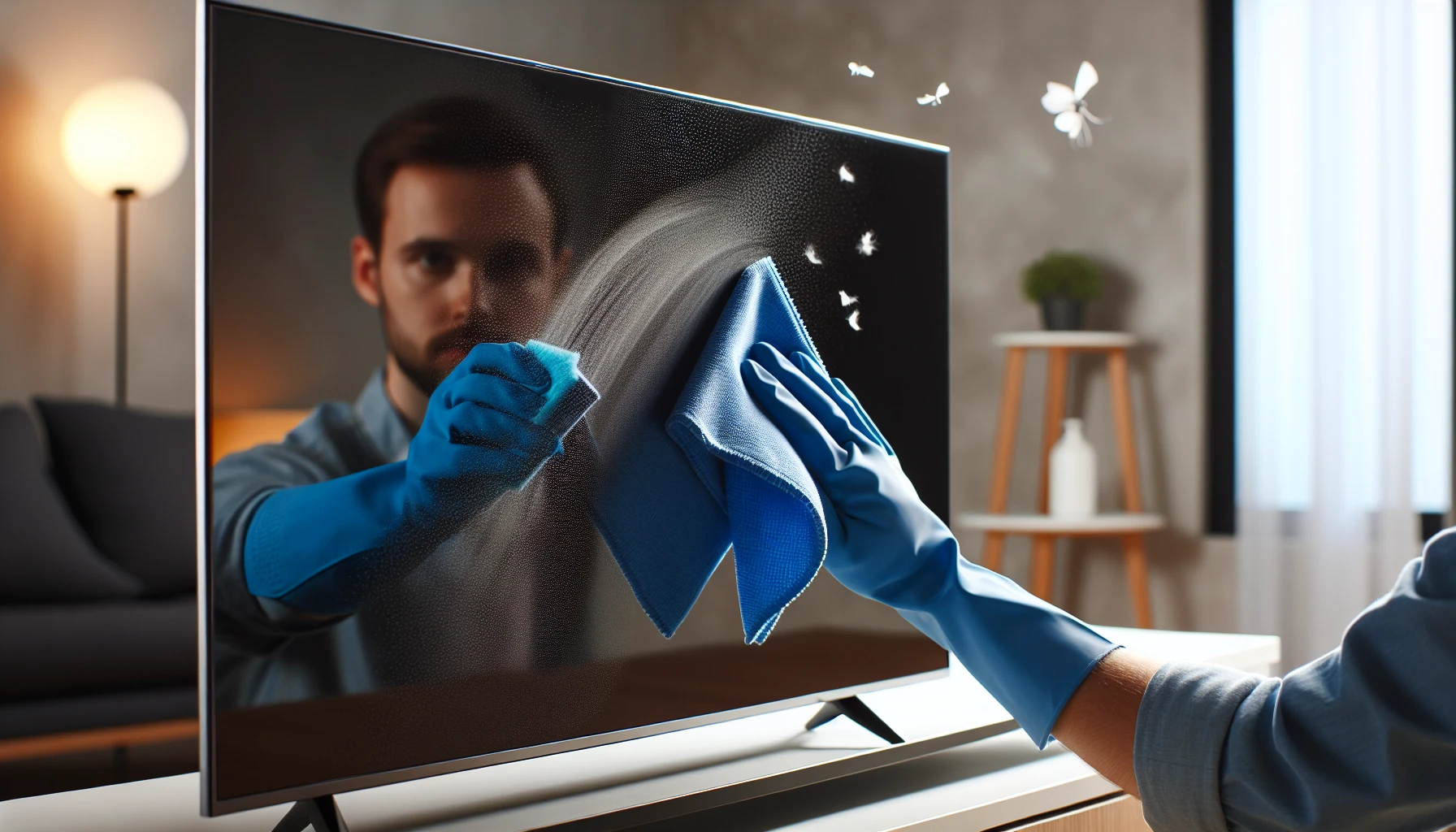
To keep the television screen clear and pristine for optimal viewing, create a habit of regularly wiping it down while immediately addressing spills or fingerprints. Doing this helps maintain its spotlessness, consequently preserving your TV’s longevity.
Regular Dusting Routine
Regular dusting is required to ensure clear images and a spotless television screen. A microfiber cloth or disposable duster designed for electronics should gently wipe the surface in one direction without causing streaks or smudges. Weekly cleaning with dry cloths is recommended to remove dirt, fingerprints, and other particles that could accumulate on your TV set’s display. This approach will keep your device well-maintained and enable an optimal viewing experience over time.
Dealing with Immediate Spills
To protect the clarity and integrity of your television screen, any messes or smudges should be addressed immediately. For a safe solution, use a microfiber cloth with diluted dish soap or a specialized TV cleaner in circular motions to gently wipe up spills before permanent harm is done. This way, you can enjoy an optimal viewing experience without worrying about damage to your TV’s display.
Special Considerations for Different Types of Screens
Taking good care of your TV screens is essential, especially regarding plasma and tube TVs. Cleaning these differently structured monitors requires specific cleaning techniques for their unique surfaces and coatings. This guide will outline everything you need to know to keep the screen looking its best.
Handling Plasma Screens
Plasma screens have delicate anti-glare coatings that must be handled carefully when cleaning. To keep your screen in optimal condition, use a dry microfiber cloth and gently wipe the surface in circles using no liquid cleaners or other harsh chemicals. This will help ensure lasting clarity and vibrancy while avoiding potential damage from more aggressive methods of wiping or scrubbing the surface. Using a damp cloth with very mild dish soap is also an option if there are persistent stains. Dilute it first before applying it to the cleaning material for safe application on plasma displays!
Caring for Tube Televisions
To maintain the condition and quality of a tube television screen, it is essential to provide proper care and cleaning. Begin by dampening a microfiber cloth with an approved window or surface cleaner solution. Once done, softly wipe the flat screen without putting too much pressure that could damage its glass finish. Doing this will extend your enjoyment of movies and shows on your YouTube TV for many years! Compared to modern flat screens, compared to modern flat screens. TVs require extra caution when taking clean-up measures, ensuring they look fabulous each time you use them!
Preventive Measures to Keep Your TV Screen Clean
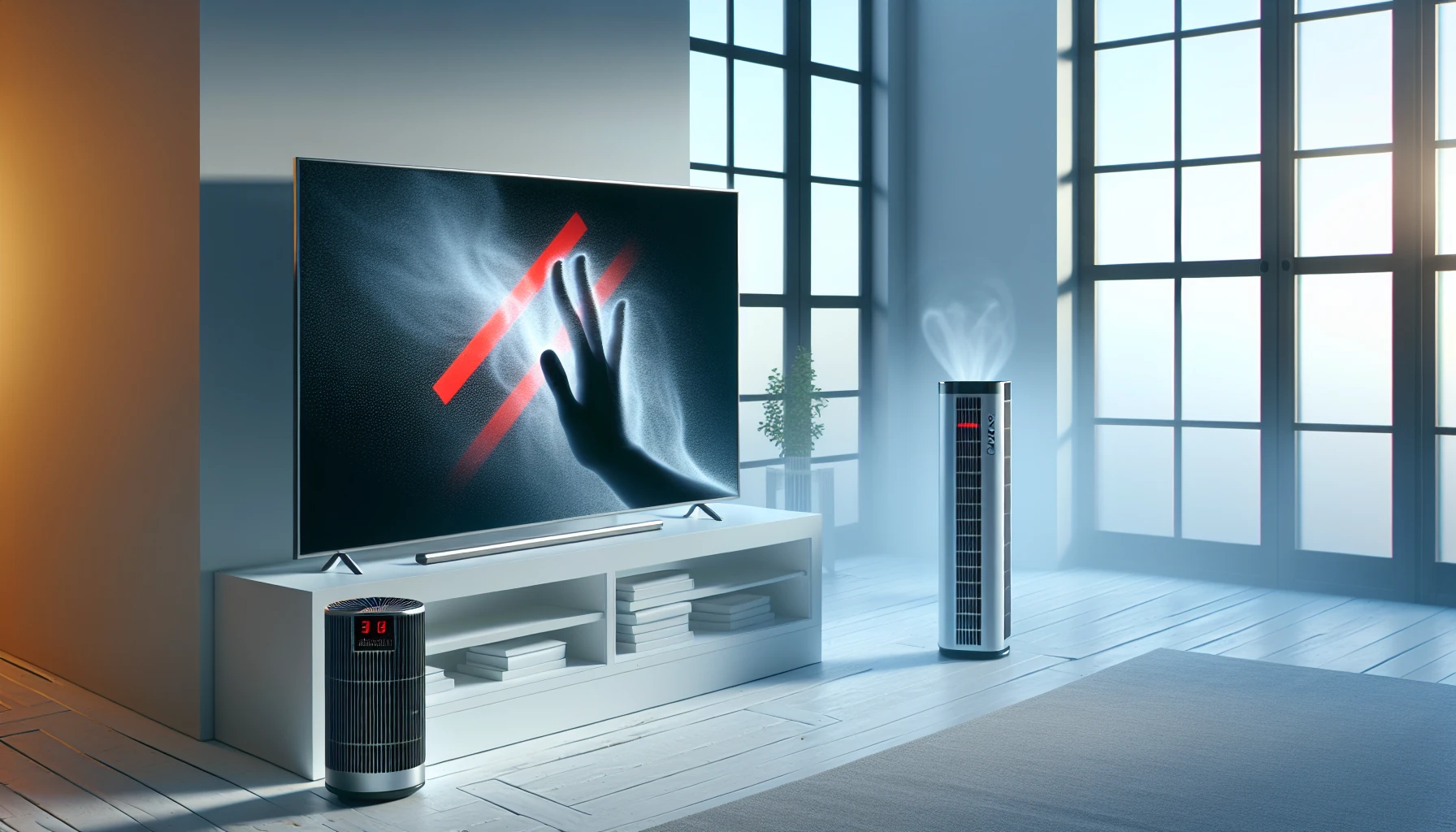
To preserve optimal picture quality, it’s essential to take steps for preventive maintenance of your TV screen. Position the television in an environment with low dust and avoid touching its surface. By doing so, you can have a clear viewing experience over time.
Summary
To ensure a superior picture that lasts for many years, it’s necessary to maintain the cleanliness of your television screen. This article offers valuable tips on appropriate tools and techniques based on the type of TV used, which can help you achieve an immaculate view with rich clarity when watching movies or shows. Keep in mind these instructions for cleaning your TV screen. They will undoubtedly result in long-lasting satisfaction from high-definition visuals!
Frequently Asked Questions
What is the best way to clean a flat screen TV?
For optimal results, using a soft microfiber cloth with no lint is essential when cleaning your flat-screen TV. Do not spray cleaner directly onto the surface. Instead, put some on the fabric and then apply it to clean the television. Not utilizing window cleaners, solvents, or any other harsh chemicals while cleaning your television screen is essential.
Can I use Windex on a flat screen TV?
Using Windex on a flat-screen TV is not advised due to its harsh ingredients, like alcohol and ammonia, which can cause damage. Taking extra care when dealing with your flat panel or LCD television is essential to preserve its condition.
Can I use glasses wipes on my TV?
Using glasses cleaner on a TV is possible, but it should be sprayed onto a cloth and not the screen directly. A soft microfiber piece of fabric dampened with the solution must then be used to carefully wipe over the television without putting much pressure on you to clean off any dirt or smudges.
How often should I clean my TV screen?
Clean your TV screen regularly to keep its quality and avoid dust accumulation. Weekly cleaning is essential for optimum picture clarity!
How should I clean the speakers on my TV?
Take a damp microfiber cloth and carefully wipe down your TV speakers, gently. If there are any covers over the speaker area that can be removed safely, take them off to give both components of the system a thorough clean. Take caution not to cause damage while doing so.
